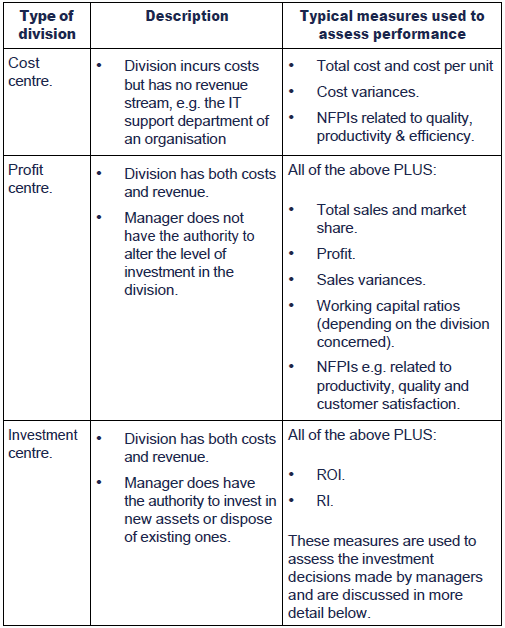Divisional Performance Management
When designing their organisational structure, many firms choose a divisional structure. This raises a number of key performance management issues that are discussed on this page.
Problems with divisionalisation
Divisional structures may result in the following problems:
- Co-ordination - how to co-ordinate different divisions to achieve overall corporate objectives.
- Goal congruence - managers will be motivated to improve the performance of their division, possibly at the expense of the larger organisation.
- Head office costs - whether/how head office costs should be reapportioned.
- Transfer prices - how transfer prices should be set as these effectively move profit from one division to another.
- Controllability - divisional managers should only be held accountable for those factors that they can control. The performance of a division's manager must be appraised separately to the performance of the division. It may be difficult to determine exactly what is and what is not controllable.
- Inter-dependence of divisions - the performance of one division may depend to some extent on others, making it difficult to measure performance levels.
Illustration - Inter-dependence of divisions
Suppose division A makes components that are subsequently used in division B to make the finished item that is then sold to customers. The following are examples of areas where the performance of B will be affected by problems in A.
- Productivity - suppose some staff in division A are ill, slowing down the supply of components to division B. This will slow down division B as well, unless adequate inventories are held.
- Profitability - suppose the transfer pricing system includes an element of actual cost. Cost overruns in A would be passed on to B.
- Quality - poor quality work in A will ultimately compromise the quality of the finished product.
- Service levels - customer queries to B could involve A's component in which case they need to be re-directed. Division A may not be as customer-focused as B, compromising customer goodwill.
Management of a division
The management of a division are normally remunerated on a basis linked to the performance they achieve. Typically, they are given performance targets and only if they achieve those targets do they get a salary bonus.
The central idea is that the manager of a division is in the same position as an independent entrepreneur. If he experiences the risks and rewards of business ownership, then he/she will act in a manner calculated to maximise the value of the division - or that is the theory. The modern variation on this theme is to give management 'share options' - the right to buy shares at a given price. If the share price performs well, (and the stock market is a good judge of business performance), then the manager benefits. The theory is that this promotes goal congruence between managers and shareholders.
Having decentralised, it is essential that senior management monitor and control the performance of the divisions and of those people with direct responsibility for those divisions. An accounting information system (a management control system) must be in place to allow for divisional assessment. The system used must have a close bearing on divisional goals and must recognise that some costs of a division will be controllable by its managers and some will not.
Measuring divisional performance - overview
When assessing divisional performance it is vital that the measures used match the type of division:

Important point: For each of these care must be taken to assess managers on controllable factors only. So for example, the manager of a cost centre should only be assessed on controllable costs.
In many respects cost and profit centres involve the use of fairly conventional financial and non-financial performance indicators. However, with investment centres we also use return on investment (ROI) and residual income (RI). A further complication with divisional performance appraisal is the way internal transfer pricing can affect results.
|
Created at 6/6/2012 3:41 PM by System Account
(GMT) Greenwich Mean Time : Dublin, Edinburgh, Lisbon, London
|
Last modified at 11/14/2012 10:17 AM by System Account
(GMT) Greenwich Mean Time : Dublin, Edinburgh, Lisbon, London
|
|
|
|
 |
Rating
:
|
 Ratings & Comments
(Click the stars to rate the page) Ratings & Comments
(Click the stars to rate the page)
|
 |
Tags:
|
|